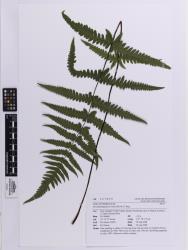Terrestrial ferns. Rhizomes erect to short- or long-creeping, scaly. Rhizome scales narrowly ovate, with short hairs on the surface. Fronds monomorphic. Stipes scaly and sometimes hairy (not NZ). Laminae deeply 1–2-pinnate-pinnatifid, herbaceous or coriaceous, the proximal pinnae somewhat reduced in size; aerophores absent; abaxial surface of laminae lacking scales, bearing unicellular acicular hairs, sometimes bearing short-stalked glands, lacking sessile spherical glands. Veins free, ending in clavate hydathodes, not reaching the margin. Sori oblong, exindusiate; paraphyses absent. Sporangia glabrous or with short acicular hairs. Spores monolete, reticulate or foveolate.
Holttum (1969, 1971) recognised Pseudophegopteris as a distinct genus of Thelypteridaceae with about 20 species, mostly in the Old World tropics and subtropics. He considered it very close to Macrothelypteris in having ± bipinnate fronds with adnate pinnules, free veins, and a base chromosome number of 31. It differed in that the scales on the lamina axes were often reduced to a row of short cells with brown cross-walls, the hairs were never multicellular, and the sori always exindusiate. Holttum distinguished Pseudophegopteris from most other genera of Thelypteridaceae by the absence of grooves on the adaxial surface of the pinna midribs, and the presence of forking rather than simple veins, with tips not reaching the lamina margins or adjacent veins. Holttum’s concept remained unchanged following the classification of Fawcett & Smith (2021).
A genus of 28 species distributed in the tropics and subtropics of the Old World, from St Helena, through Africa, Madagascar, the Mascarenes, Asia, Malesia, to Samoa and Hawai‘i (Fawcett & Smith 2021); two species in the Pacific (Holttum 1977). One introduced species in New Zealand.
| Category | Number |
|---|---|
| Exotic: Casual | 1 |
| Total | 1 |
The base chromosome number in Pseudophegopteris is x = 31 (Holttum 1977; Smith 1990; Fawcett & Smith 2021).




